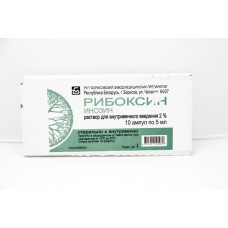Expiration date: 08/2026
Active substance: Inosine
Release Form: Solution for intravenous administration
Composition
1 ml of solution contains: inosine (Riboxin) 20 mg.
Excipients: methenamine (hexamethylenetetramine), sodium hydroxide (1 M solution of sodium hydroxide), water for injections.
Packaging: 5 or 10 vials of 5 ml.
Pharmachologic effect
Riboxin bufus - derivative (nucleoside) purines - a precursor of adenosine triphosphate (ATP). It refers to a group of medicines that stimulate metabolic processes. It has anti-hypoxic and anti-arrhythmic action. Increases myocardial energy balance, improves coronary circulation, prevents the effects of intraoperative renal ischemia. Directly involved in the metabolism of glucose and contributes to the activation of metabolism in hypoxic conditions and in the absence of ATP.
It activates the metabolism of pyruvic acid, necessary for the normal process of tissue respiration, and promotes activation of xanthine dehydrogenase. It stimulates the synthesis of nucleotides, enhances the activity of some enzymes of the Krebs cycle. Penetrating the cell has a positive effect on metabolic processes in myocardium - heart rate increases strength and enhances the myocardial diastolic relaxation, thereby increasing the stroke volume. The mechanism of antiarrhythmic action until the end is unclear.
Reduces platelet aggregation activates the regeneration of tissues (especially myocardial mucosa and gastrointestinal tract).
Testimony
Comprehensive treatment of myocardial infarction, ischemic heart disease, cardiac arrhythmias associated with the use of cardiac glycosides, amid myocardiodystrophy after infectious diseases. Liver disease (hepatitis, cirrhosis, fatty degeneration), urokoproporfirii. Operations on the isolated kidney (as a means of pharmacological protection when you turn off the blood circulation).
Contraindications
Hypersensitivity to the drug, gout, hyperuricemia, pregnancy, lactation, age 18 years (effectiveness and safety have been established).
To apply caution in patients with renal insufficiency.
Pregnancy and breast-feeding
Contraindicated during pregnancy and lactation.
Dosing and Administration
The drug is used intravenously slowly drip (40-60 drops to 1 minute). Treatment is initiated by introducing 200 mg (10 ml of a 2% solution) 1 time per day, then if tolerated, the dose was increased to 400 mg (20 ml of a 2% solution) 1-2 times a day. The duration of treatment is 10-15 days.
Stream introduction of preparation is possible in acute heart rhythm disturbances in a single dose of 200-400 mg (10-20 ml of 2% solution).
To protect renal pharmacological subjected to ischemia Riboxin administered intravenously at a dose of 1200 mg (60 ml of a 2% solution) for 5-15 minutes before the renal artery clamping, and then another 800 mg (40 ml of a 2% solution) immediately after restoration of blood circulation .
When the vein drip 2% solution of the drug is diluted in 5% dextrose (glucose) or isotonic sodium chloride solution (250 mL).
Side effects
Allergic reactions: itching, skin redness, urticaria (drug should be discontinued).
Rare: increased concentration of uric acid in the blood, gout exacerbation (with prolonged use).
Special instructions
Riboxin does not apply to emergency correction of cardiac activity.
Drug interactions
When used as part of combination therapy Riboxin enhances the effectiveness of antiarrhythmic, antianginal and inotropic drugs.
Storage conditions
Store in a dark place at a temperature of 15 to 25 ° C.
Shelf life: 3 years.


